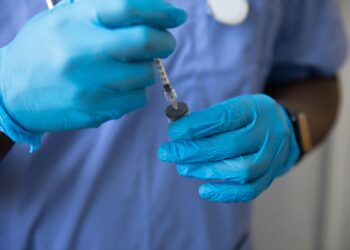Medical historians who study the 1918 Influenza pandemic have a term for communities that experienced a more severe second wave following a more mild initial wave – escape communities.
Bryn Mawr College was among the most provisional of the influenza escape communities we studied. This is because while there were zero deaths resulting from influenza during the second wave of the pandemic, there were 110 cases of influenza (a case rate of 23.6% of the campus student population, which is on par or above that seen in harder hit communities). Nevertheless, because this case study raises a number of pertinent issues related to the wide spectrum of NPI taken in 1918, we included it in our report.
The first reported case of influenza at Bryn Mawr College occurred in late September 1918 in a student staying at the College Inn. The possibility of the spread of the disease was quickly made apparent, as the patient received regular student visitors. President Thomas therefore immediately attempted to have the patient moved either to the Bryn Mawr hospital or to the campus infirmary, where she could be effectively isolated.
By October 1, campus administrators had begun to enact an “absolutely strict quarantine”—by which was meant a series of NPI designed to mitigate the spread of influenza—in an attempt to deal with the “very serious outbreak of Spanish influenza” that had erupted on campus. Thomas had a strong belief in the efficacy of influenza vaccination (which, as noted elsewhere in this report, turned out to be based on an entirely different microbe than the virus that causes influenza and, hence, not efficacious), and quickly ordered its widespread use on campus. All members of Bryn Mawr’s teaching and executive staff who commuted from Philadelphia via train, along with all managers, wardens, and housekeepers, were vaccinated at the college’s expense. Students and on-campus faculty and staff were offered the vaccine at the cost of $1.00.
A series of even more restrictive measures were then implemented. Students were advised to avoid crowds (yet they were also expected to go to chapel and association meetings) and to get plenty of both exercise and rest. Students were forbidden to enter theaters and other places of public assembly, were prohibited from crossing Montgomery Avenue (the main street separating campus from town) and were informed they could not ride public transportation. Furthermore, non-resident students were excluded from the college unless they lived near enough to campus to walk. Off-campus visitors, including mothers, were henceforth prohibited from entering residence halls; mothers were allowed to see their daughters only if the daughters were ill and being cared for at the infirmary. Students were likewise forbidden to visit private homes (even those on the campus side of Montgomery Avenue) without the express permission of the dean. All gatherings save those of an academic or religious purpose were prohibited. In late October, in response to a new regulation from the Pennsylvania Board of Health calling for an end to public gatherings and recommending the closure of schools, Thomas ordered the four-day quarantine of all students returning to campus from home.
Despite these restrictions, life at Bryn Mawr seemed to continue in a fairly regular fashion, and the various NPI to prevent the spread of influenza do not appear to have been as strict as they could have been. In the first week of October the college held its thirty-fourth annual opening ceremony in Bryn Mawr’s overflowing chapel. Liberty Loan rallies, tennis tournaments, hockey games, and chapel services continued throughout the semester. In early November, the traditional “Lantern Night” event (a ritual in which freshmen are handed colored lanterns by sophomores while singing Pallas Athena) was held before “a quarantine audience of Faculty and upperclassmen.” Some students were also allowed to sleep in residence halls other than their own, a violation of the campus health department orders. At least one student, apparently unaware of the protective sequestration and the ban on leaving campus, was discovered to be regularly wandering the aisles of Wanamaker’s department store in downtown Philadelphia.
Whether as a result of lax measures or from other causes, influenza did spread throughout the campus. On October 17 the school newspaper reported 42 cases of influenza, four of which had developed into bronchial pneumonia. By the end of the second wave of the pandemic in mid-November, the college had experienced some 110 influenza cases (not including those infected at home) out of a total population of 465 students (or 23.6% of the campus population). Several faculty members, including Dean Helen Taft (daughter of former President and Chief Justice William Howard Taft), also became ill. No deaths, however, were recorded as a result of these infections.
Source: Univeristy of Michigan Center for the History of Medicine















